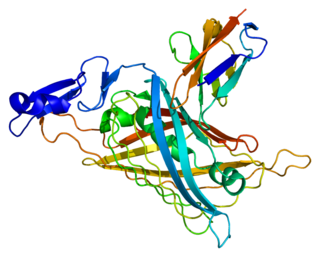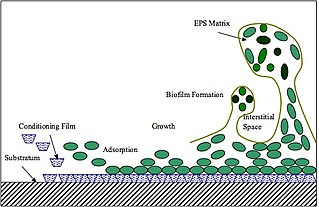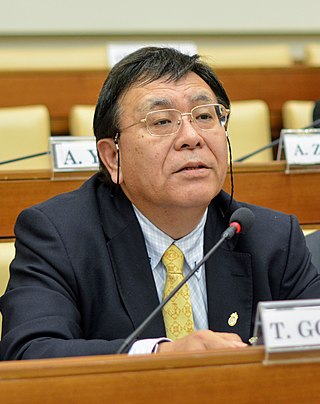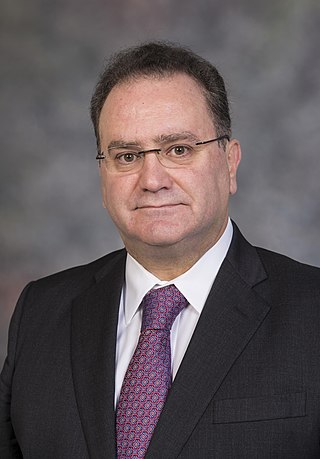
In biology, the extracellular matrix (ECM), also called intercellular matrix, is a network consisting of extracellular macromolecules and minerals, such as collagen, enzymes, glycoproteins and hydroxyapatite that provide structural and biochemical support to surrounding cells. Because multicellularity evolved independently in different multicellular lineages, the composition of ECM varies between multicellular structures; however, cell adhesion, cell-to-cell communication and differentiation are common functions of the ECM.

A biomolecule or biological molecule is a loosely used term for molecules present in organisms that are essential to one or more typically biological processes, such as cell division, morphogenesis, or development. Biomolecules include the primary metabolites which are large macromolecules such as proteins, carbohydrates, lipids, and nucleic acids, as well as small molecules such as vitamins and hormones. A more general name for this class of material is biological materials. Biomolecules are an important element of living organisms, those biomolecules are often endogenous, produced within the organism but organisms usually need exogenous biomolecules, for example certain nutrients, to survive.

Perlecan (PLC) also known as basement membrane-specific heparan sulfate proteoglycan core protein (HSPG) or heparan sulfate proteoglycan 2 (HSPG2), is a protein that in humans is encoded by the HSPG2 gene. The HSPG2 gene codes for a 4,391 amino acid protein with a molecular weight of 468,829. It is one of the largest known proteins. The name perlecan comes from its appearance as a "string of pearls" in rotary shadowed images.
Mary Higby Schweitzer is an American paleontologist at North Carolina State University, who led the groups that discovered the remains of blood cells in dinosaur fossils and later discovered soft tissue remains in the Tyrannosaurus rex specimen MOR 1125, as well as evidence that the specimen was a pregnant female when she died.
Biomolecular engineering is the application of engineering principles and practices to the purposeful manipulation of molecules of biological origin. Biomolecular engineers integrate knowledge of biological processes with the core knowledge of chemical engineering in order to focus on molecular level solutions to issues and problems in the life sciences related to the environment, agriculture, energy, industry, food production, biotechnology and medicine.

Extracellular polymeric substances (EPSs) are natural polymers of high molecular weight secreted by microorganisms into their environment. EPSs establish the functional and structural integrity of biofilms, and are considered the fundamental component that determines the physicochemical properties of a biofilm. EPS in the matrix of biofilms provides compositional support and protection of microbial communities from the harsh environments. Components of EPS can be of different classes of polysaccharides, lipids, nucleic acids, proteins, lipopolysaccharides, and minerals.

Takashi Gojobori is a Japanese molecular biologist, Vice-Director of the National Institute of Genetics (NIG) and the DNA Data Bank of Japan (DDBJ) at NIG, in Mishima, Japan. Gojobori is a Distinguished Professor at King Abdullah University of Science and Technology (KAUST) in Thuwal, Saudi Arabia. He is a Professor of Bioscience and Acting Director at the Computational Bioscience Research Center at KAUST.

Collagenase 3 is an enzyme that in humans is encoded by the MMP13 gene. It is a member of the matrix metalloproteinase (MMP) family. Like most MMPs, it is secreted as an inactive pro-form. MMP-13 has an predicted molecular weight around 54 kDa. It is activated once the pro-domain is cleaved, leaving an active enzyme composed of the catalytic domain and the hemopexin-like domain PDB: 1PEX. Although the actual mechanism has not been described, the hemopexin domain participates in collagen degradation, the catalytic domain alone being particularly inefficient in collagen degradation. During embryonic development, MMP-13 is expressed in the skeleton as required for restructuring the collagen matrix for bone mineralization. In pathological situations it is highly overexpressed; this occurs in human carcinomas, rheumatoid arthritis and osteoarthritis.

Invadopodia are actin-rich protrusions of the plasma membrane that are associated with degradation of the extracellular matrix in cancer invasiveness and metastasis. Very similar to podosomes, invadopodia are found in invasive cancer cells and are important for their ability to invade through the extracellular matrix, especially in cancer cell extravasation. Invadopodia are generally visualized by the holes they create in ECM -coated plates, in combination with immunohistochemistry for the invadopodia localizing proteins such as cortactin, actin, Tks5 etc. Invadopodia can also be used as a marker to quantify the invasiveness of cancer cell lines in vitro using a hyaluronic acid hydrogel assay.

Pamela Christine Ronald is an American plant pathologist and geneticist. She is a professor in the Department of Plant Pathology and the Genome Center at the University of California, Davis and a member of the Innovative Genomics Institute at the University of California, Berkeley. She also serves as Director of Grass Genetics at the Joint BioEnergy Institute in Emeryville, California. In 2018 she served as a visiting professor at Stanford University in the Center on Food Security and the Environment.
Cynthia Beall is an American physical anthropologist at the Case Western Reserve University, Cleveland, Ohio. Four decades of her research on people living in extremely high mountains became the frontier in understanding human evolution and high-altitude adaptation. Her groundbreaking works among the Andean, Tibetan and East African highlanders are the basis of our knowledge on adaptation to hypoxic condition and how it influences the evolutionary selection in modern humans. She is currently the Distinguished University Professor, and member of the U.S. National Academy of Sciences and the American Philosophical Society.

Cynthia J. Burrows is an American chemist, currently a distinguished professor in the department of chemistry at the University of Utah, where she is also the Thatcher Presidential Endowed Chair of Biological Chemistry. Burrows was the Senior Editor of the Journal of Organic Chemistry (2001-2013) and became Editor-in-Chief of Accounts of Chemical Research in 2014.,,

Antonios Georgios Mikos is a Greek-American biomedical engineer who is the Louis Calder Professor of Bioengineering and Chemical and Biomolecular Engineering at Rice University. He specialises in biomaterials, drug delivery, and tissue engineering.
Anna Marie Pyle is an American academic who is a Sterling Professor of Molecular, Cellular & Developmental Biology and a Professor of Chemistry at Yale University. and an Investigator for Howard Hughes Medical Institute. Pyle is the president of the RNA Society, the vice-chair of the Science and Technology Steering Committee at Brookhaven National Laboratory, and previously she served as chair of the Macromolecular Structure and Function A Study Section at the National Institutes of Health.
Keiko Torii is a Japanese plant scientist and academic teaching at the University of Texas at Austin as of September 2019.
Cynthia M. Bauerle is an American molecular biologist and college administrator. They are currently the interim vice provost for Faculty and Curriculum at James Madison University.
Mary E. Lidstrom is a Professor of Microbiology at the University of Washington. She also holds the Frank Jungers Chair of Engineering, in the Department of Chemical Engineering. She currently is a fellow of the American Academy of Microbiology, a member of the National Academy of Sciences and serves on the editorial boards of the Journal of Bacteriology and FEMS Microbial Ecology.
Cynthia Casson Morton is an American geneticist, professor at Harvard Medical School, and director of cytogenetics at Brigham and Women's Hospital.
Christy F. Landes is an American physical chemist who is the Jerry A. Walker Endowed Chair in chemistry at the University of Illinois Urbana-Champaign. She previously was the Kenneth S. Pitzer-Schlumberger Chair at Rice University. She seeks to understand the structure-function relationships in biological processes and materials. She was appointed a National Academy of Sciences Kavli Fellow in 2019.
Lynda Bonewald is a professor of anatomy, cell biology, physiology, and orthopaedic surgery and the founding director of the Indiana Center for Musculoskeletal Health (ICMH) at the Indiana University School of Medicine. She studies bone and the musculoskeletal system. She has served as president of the American Society for Bone and Mineral Research and the Association of Biomolecular Resource Facilities (1999-2000).









